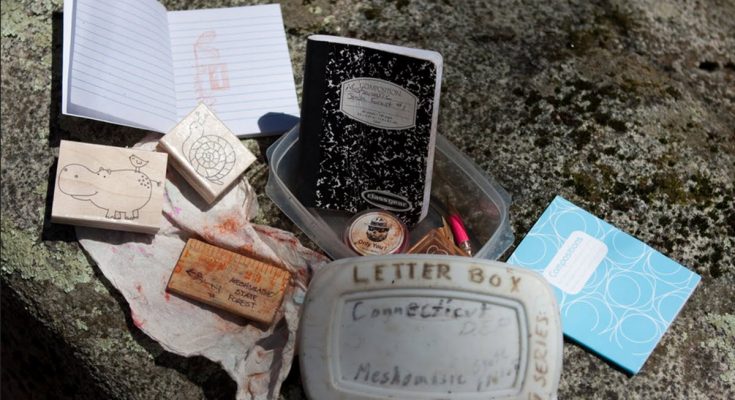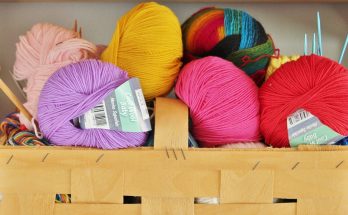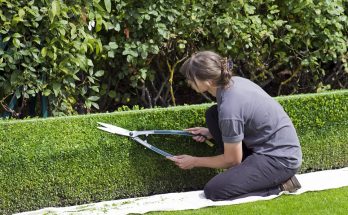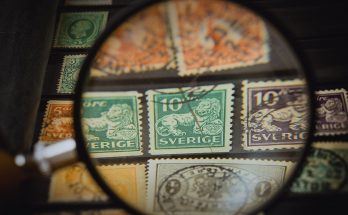Letterboxing is a hobby where a small, waterproof box is placed in a publicly accessible place and filled with a rubber stamp and a notebook (known as the logbook or visitor’s book). Clues pointing to the box’s location are then published in printed catalogs, online or spread by word of mouth. A letterbox enthusiast will gather the clues and use them to locate the box, carrying their own notebook and personal stamp with them. When a box has been located, the finder will use their own stamp to put their mark in the box’s logbook, while also using the box’s stamp to put a mark in their own notebook.
Letterboxing is a hobby that arose in the 1800s and combines elements of orienterring and puzzle solving. The stamps used are normally hand carved.
Letterboxing have many smililarities with the much more modern hobby geocaching.
In the UK
The hobby originated in Great Britian and this is still the country where the hobby is most commonly practised. Letterboxes are found in various parts of the UK, with Dartmoor National Park and The North York Moors being two especially letterbox dense areas.
Some of the boxes are placed to be accessible for children and inexperienced hikers, while others are considerably more difficult to reach and locate.
Twice a year, on the “clock change days” in March and October, a letterbox hobbyist gathering is held on Dartmoor in Devon, England.
Background
Letterboxing started in the mid 19th century on Dartmoor, an area of moorland in southern Devon, England, UK. In his book “Guide to Dartmoor”, William Crossing claims that a Dartmoor tourist guide named James Perrott placed a bottle for visiting cards by the Cranmere Pool in 1854. Cranmere Pool is a small depression in the peat bog in northern Dartmoor.
Eventually, a box was placed along one of the trails on Dartmoor and hikers began placing letters and postcards inside it – adressed either to themselves or to someon they knew. Passers by who knew that they would visit a place with a post office soon would take letters and postcards out of the box and make sure they were mailed.
In 1938, a memorial plaque for William Crossing was placed together with a letterbox at the Duck’s Pool in the southern part of the moor by members of a walking club known as Dobson’s Moormen.
Letterboxing on the Dartmoor
The letterbox hobby slowly grew on Dartmoor, with letterboxes being placed in remote and well-hidden spots where only intrepid hikers would find them. When a letter had been placed in the box, it could take many weeks before it was found by someone else and brought to the post office.
Until the 1970s, only a dozen or so letterboxes existed on the moor. Thereafter, more letterboxes were added and many of them were placed in fairly accessible spots. Eventually, there were several thousand letterboxes on the moor. Simultaneously, the tradition of placing letters and cards in the boxes died out.
Dartmoor 100 Club
The 100 Club is open for people who have found at least one hudred letterboxes on Dartmoor.
The club publish clues to the location of may letterboxes in their yearly catalogue. Not all letterboxes are included in the catalogu however – some remain “word of mouth” letterboxes or have their clues placed in other (catalogued or not catalogued) letterboxes.
Alec Finlay
The Scottish artist and poet Alec Finlay has placed one hundred letterboxes at locations around the world, including the Yorkshire Sculpture Park. Finlay’s boxes contain rubber stamp circle poems. Each letterbox has its own nominated kepper.
Letterboxing in the USA
The letterboxing hobby in the U.S. experienced a bit of a bloom after an article about the hobby was published in the Smithsonian Magazine in 1998. The first letterboxers’ gathering in the country took place at The Inn at Long Trail in Killington, Vermont in November 1999.
Letterbox gatherings in the U.S. will often involve the exchange of personal stamps. Also, a special one-day Event Stamp is created for each specific gathering.
Clues pointing to the location of letterboxes in the U.S. are usually posted online.
Letterbox variants
- Mystery box
The mystery box is normally a traditional letterbox, but especially difficult to locate due to a lack of clues, no description, no starting area given, or similar. Mystery boxes are popular among hobbyists looking for a challenge.
- Bonus box
A bonus box is typically placed in the same area as another letterbox. No clues pointin to its location are published online or offline; the clues are instead placed inside the other letterbox, so that finders of the first letterbox can start searching for the bonus box.
- Word of Mouth Box (WOM)
Only the planter of the letterbox hand out the clues. They are not published in any catalogue.
>
Sometimes planters of WOM boxes utilizes “cuckoo clues”. A cuckoo clue is placed in another letterbox, and the finder is espected to move the clue to another nearby letterbox.
>
- Personal Traveler
Instead of being planted somewhere, this box is kept by the creator. If the creator meets another letterboxer, the box is attainable upon request.
Som creators will spread a password and only open the box to other letterboxers who know the password.
>
- Hitchhiker
This small letterbox is placed inside another letterbox. If you find it, you stamp like you normally do, but then pick up the hitchhiker and bring it to the next letterbox.
- Cootie
The cootie is similar to a hitchhiker, but you don’t carry it to another letterbox – you bring it to another letterboxer. Letterboxers are often secretive when planting cooties, and can for instance place them with unattended bags on the trail.
- Flea
Should be treated like a hitchhiker or a cootie.
- Hitchhiker Hostel
A large letterbox intended for keeping multiple hitchhikers in. If you take one of the hitchhikers out, you are expected to put another hitchhiker in.
- Limited Time Box
A letterbox that will only be out there for pre-determined amount of time, e.g. a few days or a few weeks.





